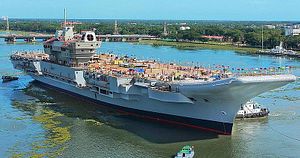The Indian Navy is devoting enormous resources to the development of an effective, multi-ship carrier force. It remains unclear, however, precisely how the Indian Navy would use that force in the event of a rekindled war with Pakistan. A recent Naval War College Review article by Ben Wan Beng Ho sheds some light on the problems that India’s carrier force might have in taking the fight to Pakistan. Long story short, India’s carriers would face enormous risks in undertaking offensive operations, with very uncertain benefits.
Ho argues that the need for self-defense, combined with limited deck space, make it very difficult for INS Vikrant and INS Vikramaditya, either separately or in tandem, to threaten Pakistani land installations. Pakistan’s A2/AD network, including submarines, aircraft, and surface ships, poses a credible threat to the carriers, making their use in offensive operations very risky. Conceivably, Pakistan could even attack Indian carriers with tactical nuclear weapons, if the war developed in that direction. The Indian carriers would struggle to execute a close blockade of Pakistani ports, destroy the Pakistani surface fleet, or do much damage to Pakistani military targets on land.
Ho suggests that the carrier fleet would be better employed as a decisive late-war weapon, after Indian Air Force assets had worn down Pakistani defenses. This would have the benefit of enabling India to bring its entire carrier force to bear. Ho also argues that the carriers could play a productive role in sea lines of communication (SLOC) protection, which might also allow them to threaten Pakistani lines of communication.
Ho details the problems associated with small-deck carriers, especially the limited number of aircraft to share offensive and defensive missions. The need for self-protection is not entirely problematic; Indian carriers will undoubtedly receive a great deal of attention from potential opponents, drawing resources away from other military operations. Other Indian naval forces could either use this misdirection to conduct offensive operations, or could rely on the defensive umbrella provided by the carriers.
But some core problems remain. Indian naval strategy envisions three operational carrier battle groups undertaking more or less the same tasks. But Indian naval procurement has produced a plan to acquire three carriers with radically different capabilities, meaning that the actual utility of the carrier battle group in crisis conditions will depend upon which carrier is operational at a given time.
We also have no clear idea regarding the reliability of the two existing ships. Vikramaditya is an old Russian hull that underwent controversial late-life transformation into a STOBAR carrier; Vikrant is a purpose-built STOBAR carrier, but will be the largest warship ever constructed in India, with all of the potential reliability issues that this entails. The two ships are similar but not identical, meaning that maintenance and flight procedures will vary in potentially consequential ways. This makes sharing aircraft and pilots a dicey proposition.
Moreover, as Ho notes, the reports we have regarding readiness in the naval aviation program are not great. The MiG-29K has been a carrier aircraft for less than a decade, and has never been subjected to a demanding, up tempo set of combat operations. Anecdotes from the Russian experience do not suggest optimism.
While Vikrant and Vikramaditya will provide important opportunities for learning, the Indian Navy may need to wait for the commissioning of INS Vishal, projected in the 2030s, to have a real offensive capability against Pakistan. By that time, however, the lethality of Pakistan’s A2/AD umbrella may have significantly increased.
































